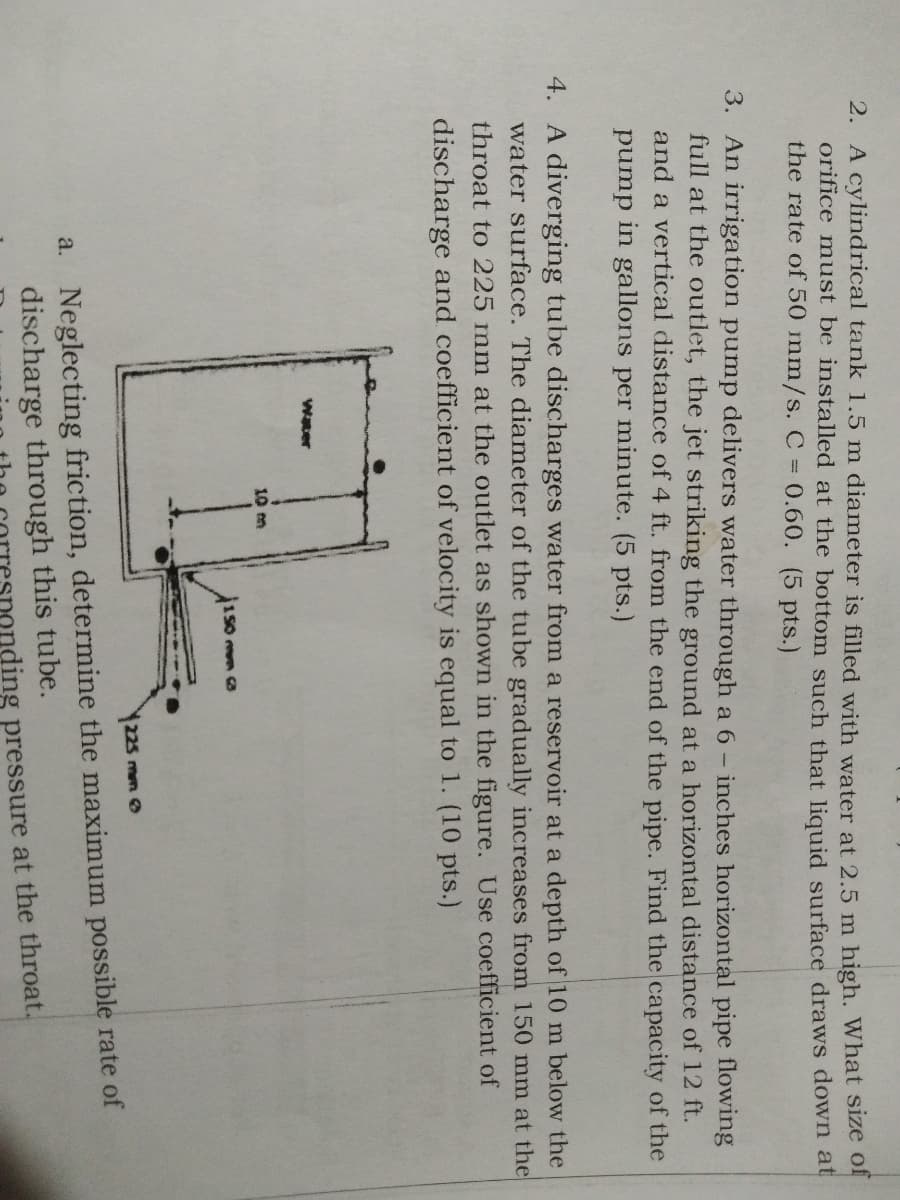3. An irrigation pump delivers water through a 6 - inches horizontal pipe flowing full at the outlet, the jet striking the ground at a horizontal distance of 12 ft. and a vertical distance of 4 ft. from the end of the pipe. Find the capacity of th pump in gallons per minute. (5 pts.)
3. An irrigation pump delivers water through a 6 - inches horizontal pipe flowing full at the outlet, the jet striking the ground at a horizontal distance of 12 ft. and a vertical distance of 4 ft. from the end of the pipe. Find the capacity of th pump in gallons per minute. (5 pts.)
Chapter2: Loads On Structures
Section: Chapter Questions
Problem 1P
Related questions
Question

Transcribed Image Text:2. A cylindrical tank 1.5 m diameter is filled with water at 2.5 m high. What size ol
orifice must be installed at the bottom such that liquid surface draws down at
the rate of 50 mm/s. C = 0.60. (5 pts.)
3. An irrigation pump delivers water through a 6- inches horizontal pipe flowing
full at the outlet, the jet striking the ground at a horizontal distance of 12 ft.
and a vertical distance of 4 ft. from the end of the pipe. Find the capacity of the
pump in gallons per minute. (5 pts.)
4. A diverging tube discharges water from a reservoir at a depth of 10 m below the
water surface. The diameter of the tube gradually increases from 150 mm at the
throat to 225 mm at the outlet as shown in the figure. Use coefficient of
discharge and coefficient of velocity is equal to 1. (10 pts.)
Water
10 m
225 mm o
Neglecting friction, determine the maximum possible rate of
discharge through this tube.
a.
ling pressure at the throat.
Expert Solution
This question has been solved!
Explore an expertly crafted, step-by-step solution for a thorough understanding of key concepts.
This is a popular solution!
Trending now
This is a popular solution!
Step by step
Solved in 2 steps

Knowledge Booster
Learn more about
Need a deep-dive on the concept behind this application? Look no further. Learn more about this topic, civil-engineering and related others by exploring similar questions and additional content below.Recommended textbooks for you


Structural Analysis (10th Edition)
Civil Engineering
ISBN:
9780134610672
Author:
Russell C. Hibbeler
Publisher:
PEARSON

Principles of Foundation Engineering (MindTap Cou…
Civil Engineering
ISBN:
9781337705028
Author:
Braja M. Das, Nagaratnam Sivakugan
Publisher:
Cengage Learning


Structural Analysis (10th Edition)
Civil Engineering
ISBN:
9780134610672
Author:
Russell C. Hibbeler
Publisher:
PEARSON

Principles of Foundation Engineering (MindTap Cou…
Civil Engineering
ISBN:
9781337705028
Author:
Braja M. Das, Nagaratnam Sivakugan
Publisher:
Cengage Learning

Fundamentals of Structural Analysis
Civil Engineering
ISBN:
9780073398006
Author:
Kenneth M. Leet Emeritus, Chia-Ming Uang, Joel Lanning
Publisher:
McGraw-Hill Education


Traffic and Highway Engineering
Civil Engineering
ISBN:
9781305156241
Author:
Garber, Nicholas J.
Publisher:
Cengage Learning